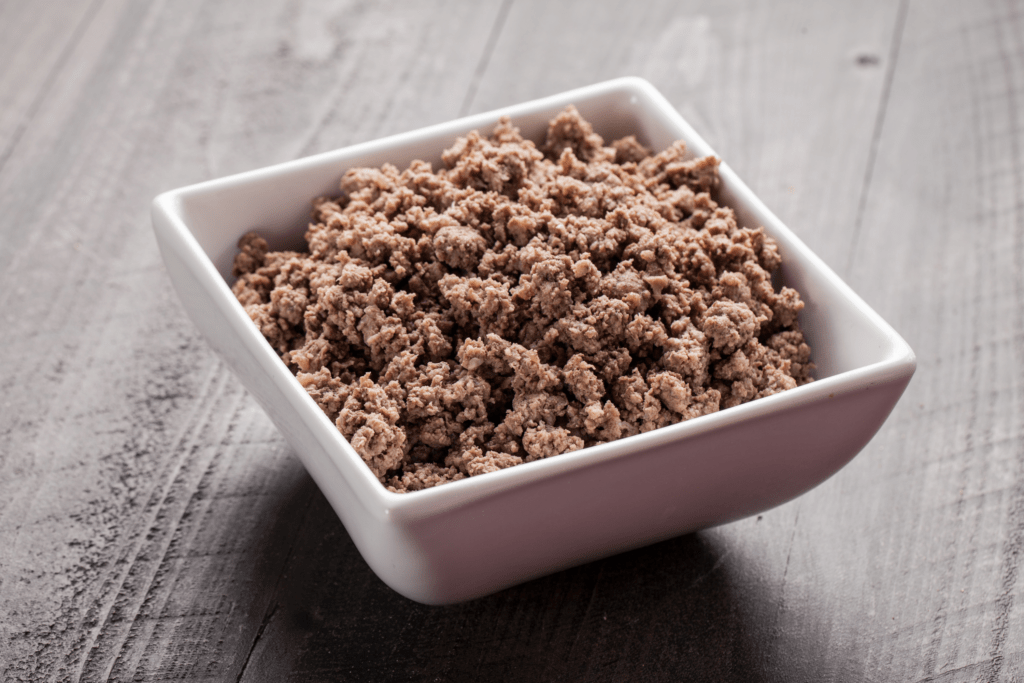This post contains affiliate links, meaning, at no additional cost to you, if you click through and make a purchase, I may receive a commission. I only share items that I truly love and use myself. For more information please see my disclosures here.
Be sure to listen to the
She’s Got It Together Podcast!
SUMMARY: Drain ground beef using a colander lined with aluminum foil over a bowl to catch grease, preventing plumbing problems; after grease hardens, safely dispose of it to keep meals healthful and kitchens clean. Enhance flavor and save time by seasoning the beef before freezing, and reduce fat by cooking with minimal stirring for better browning.
Ever been frustrated by the greasy mess after cooking ground beef?
Learn the efficient way to drain grease, avoid plumbing havoc, and keep your kitchen clean.
- A step-by-step guide to draining ground beef without the mess
- The dangers of pouring grease down the sink
- Tips for optimal cooking and browning
- Seasoning and freezing techniques for your convenience
Read on to master the art of draining ground beef like a pro and make clean-up a breeze.
Preparing to Drain Ground Beef
Proper preparation is key to efficiently draining ground beef and maintaining a tidy kitchen. Before you begin cooking, it’s important to understand why draining ground beef is necessary and to gather a few common kitchen items.
- Draining ground beef removes excess fat, improving the texture and healthiness of your meals.
- To get started, you’ll need aluminum foil, a bowl large enough to catch the grease, and a colander that fits snugly over the bowl.
Having these items at hand before you start cooking will streamline the draining process and prevent any unnecessary mess in your kitchen.
Draining Technique Step-by-Step
Mastering the art of draining ground beef is straightforward when following these simple steps. With the right technique, you can ensure that your ground beef is free of excess grease, enhancing the quality and healthfulness of your meals.
- Line Your Colander: Begin by taking a large colander and lining it with a sheet of aluminum foil. Mold the foil to the sides of the colander, ensuring it will catch the grease as you drain the beef.
- Transfer the Beef: After cooking the ground beef to your desired level of doneness, carefully transfer it from the pan to the colander. Holding the pan securely, tilt it slowly into the colander, allowing the beef to slide out gently. This prevents splashing and ensures all the grease heads straight into the foil.
- Let It Drain: Allow the beef to sit in the colander for a few minutes. During this time, the excess grease will drain away from the meat and pool into the foil.
- Discard the Grease Safely: Once the beef has drained and the grease has cooled down slightly (but not completely hardened), carefully lift the edges of the aluminum foil to create a makeshift pouch containing the grease. Be cautious to avoid any spillage.
- Let Grease Harden: Set the foil pouch aside on a heatproof surface and let it cool down for about 30 minutes, or until the grease has solidified. This duration can vary depending on the amount of grease and the room temperature.
- Disposal of Grease: With the grease now in a semi-solid state, wrap it thoroughly with the same piece of foil, making sure that no grease can leak out. You can then responsibly dispose of it in your household trash.
- Clean Up: Finally, take a sheet of paper towel and wipe out any remaining grease in the colander. This step helps minimize waste and keeps your kitchen tools clean.
By meticulously following these steps, you can effortlessly drain your ground beef and keep your kitchen clean. Adhering to this process not only benefits your cooking routine but also contributes to the environment by avoiding unnecessary plumbing issues.
Tips for Minimizing Grease
- To reduce the amount of grease from the very beginning, select leaner cuts of ground beef if available. Look for packages labeled with a higher ratio of meat to fat, such as 90/10 or 93/7.
- Consider cooking techniques that naturally minimize fat content. For example, browning your ground beef in a hot, non-stick skillet can reduce the need for added oils, allowing the meat to cook in its own fat and thus reducing the overall grease content.
- While browning the meat, resist the urge to stir it too frequently. Allowing the meat to sit undisturbed on a hot surface will create a better sear and promote caramelization, which not only enhances flavor but also helps to render out the fat more effectively.
- After the initial browning, drain the excess grease before continuing to cook the beef with other ingredients. This will ensure that your meal is not overly greasy and will keep the flavors of your ingredients at the forefront.
- If you have the time, chilling cooked ground beef in the refrigerator will cause the fat to solidify, making it easy to skim off and dispose of.
- Lastly, maintaining a clean work area and properly disposing of grease will make your cooking experience safer and more pleasant. Regularly wiping down surfaces with paper towel to remove grease spills helps prevent slipping hazards and surface contamination.
After Draining: Disposal and Seasoning Tricks
- Once you’ve drained the ground beef, ensure that all excess grease has been removed from the colander and bowl. Using a paper towel, wipe away any leftover grease to prevent it from entering your plumbing system.
- Allow the drained grease to harden in the aluminum foil lining the colander. Once solidified, carefully wrap the grease in the foil and dispose of it in the trash. This practice helps in avoiding plumbing issues.
- For the perfectly seasoned ground beef, consider adding your favorite mix of spices after draining the grease. Homemade taco seasoning not only has great flavor but also stores well when you freeze your ground beef for later use.
- When freezing seasoned ground beef, spread it flat in a zip-top bag for a fast thaw and ensure a more even distribution of seasoning.
- Label your frozen ground beef with the date and type of seasoning. That way you have a ready-to-use ingredient that can make meal prep faster and more efficient.
Final Thoughts
We’ve covered all aspects required to master this technique with ease and efficacy. Reflecting on the tips and methods, you’re now ready to keep your meals lean and your kitchen clean.
- Utilize aluminum foil, a colander, and a bowl to strain ground beef efficiently and prevent a greasy mess.
- Avoid pouring hot grease down the sink to sidestep potential plumbing disasters.
- Allow grease to harden for at least 30 minutes before disposal, ensuring an easy and safe process.
- Consider freezing seasoned ground beef to save time and enhance flavor in future meals.
- Keep stirring to a minimum when cooking ground beef to ensure optimal browning and texture.
- Wipe down your colander with a paper towel before disposing of the solidified grease wrapped in aluminum foil.
Draining Ground Beef FAQs
Why is it necessary to drain grease from ground beef?
Draining grease from ground beef is essential for both culinary and health reasons. It helps to enhance the flavor and texture of the beef by removing excess fat. The extra fat can make dishes greasy or cause them to become soggy. From a health perspective, removing grease cuts down on calories and unhealthy fats.
Can I reuse the grease from ground beef for cooking?
Yes, you can save and reuse the grease from ground beef for cooking other dishes. Store the cooled grease in a container in the refrigerator and use it as you would other fats in cooking. But be mindful of the additional fat content it can add to your recipes.
What is the best way to dispose of ground beef grease after draining?
The best way to dispose of ground beef grease is to let it solidify completely. Once solidified, it can be wrapped in aluminum foil or placed in a container and thrown away in the trash. This method avoids the risk of clogging your sink and respects environmental disposal guidelines.
Are there healthier options for ground meat that may not require draining?
Healthier options for ground meat include leaner cuts such as ground turkey or chicken. They typically contain less fat and therefore may require less draining. However, even with leaner meats, draining any excess liquid that accumulates during cooking can still improve the texture and consistency.
Can seasonings be added to ground beef before or after draining the grease?
Seasonings can be added both before and after draining the grease from ground beef. Adding spices and herbs before cooking can infuse the meat with more flavor as it cooks. Post-draining, additional seasoning can be added to enhance flavor, especially after some of the meat’s natural juices have been removed.


